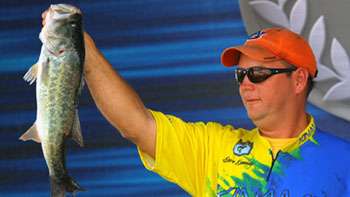
Steve Kennedy has been fishing deep his whole life. He grew up fishing Oklahoma's Lake Eufaula and says that deep fishing know-how is especially useful there. He has several tournament victories because of his deep fishing expertise, but admits that every lake is not conducive to deep-water tactics. Bass will school in the summer, following bait wherever it goes, including deeper water. If you want to keep the bite going when the fish leave the shallows, you'll need to go to greater depths.
Tip #1: Be on the move
At the beginning of summer, the fish are schooled up and aggressively feeding, says Kennedy, and once you find a school, you're almost guaranteed a few fish. But you have to find one first. Kennedy stresses the importance of fishing quickly but thoroughly.
"At (the Elite Series event on) Old Hickory I was finding five or six schools a day, while some guys couldn't find any," he says. "If you don't get a hit in about two or three casts, it's time to move on."
When he's after early summer schools, Kennedy turns to his crankbaits. Bomber's Fat Free Shads in chartreuse and blue are his first choice because he starts his search deep and moves shallower until he finds the depth at which the fish are holding. If the water is clearer he will use Citrus Shad, a more natural color.
His cranking stick is a graphite 7-foot 6-inch Kistler medium-heavy LTA rod and it is mated to a Shimano Curado 6:1 reel. He cites the graphite's sensitivity and the Curado's large line capacity as pluses. Kennedy uses 10-pound P-Line Floroclear, which is a copolymer with a fluorocarbon coating, giving it more stretch than fluorocarbon alone. He likens it to invisible monofilament.
If Kennedy gets on a school of fish and the bite stops, he will then switch to a brown and purple 3/4-ounce PJ's Finesse Baits football jig trailed by a green pumpkin Kinami Double Tail Skirted Grub.
"You can keep the bite going once it dies down with a jig," he says. "Kicking up the bottom will usually get you a few more bites."
He stresses that the most important part of fishing a football jig is keeping it in contact with the bottom, letting it feel out the bottom and rustle up debris.
Tip #2: School's out for summer
Late in the summer, the fish will break out of their schools, Kennedy says. This means slowing down and targeting deep structure to find the fish.
"Once they scatter a bit late in the summer, use your electronics to look for points and rockpiles. You can then position your boat upcurrent and use it to help you present a big worm down the edge."
Kennedy prefers Zoom's 10 1/2-inch Ol' Monster worm in plum or red with blue flake. He will Texas rig it with a Gamakatsu 5/0 round bend hook and use anywhere from a 3/8- to 1/2-ounce weight, depending on how deep he is fishing. He'll use a heavier weight if he is fishing fast or working deeper than crankbaits can reach.
Football jigs are another option for probing structure deeper than crankbaits effectively go. He will key in on hard bottom areas more when using jigs, too.
"I like to use a football jig to get a good idea of the bottom, especially when it's what my wife calls 'tickle-bottom,' meaning shell beds or gravel. The fish seems to like these areas better."
Fishing the depths can be intimidating, so use Steve Kennedy's legwork on deep fishing and you can capitalize on these deep-dwellers.




